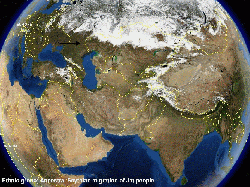Jat
History and Study of the Jat Sikhs
The original home of the Jats was in Central Asia near the country we now call Kazakstan. During the early part of the Christian era, most of the Jats were uprooted by the Mongol people from their homeland in Central Asia, after ruling there for over one thousand years. In turn Jats split into 2 groups one invaded India to the South and other invaded the Roman Empire in the West. Thus, they established themselves as the Alans in France, Spain, Portugal and so on, in the fifth century A.D.
The Jat people ethnic group which live in Northern India and Pakistan regions, have many different types of religions, professions and languages. They have a distinct cultural history that can be historically traced back to ancient times. Some have moved to Western countries for business and commercial reasons. There some have become prominent sections of the immigrant peoples in the West.
The Jats were designated in a British report as a Martial Race. ‘Martial Race’ was a designation created by officials of British India to describe “races” (peoples) that were thought to possess qualities such as courage, loyalty, self sufficiency, physical strength, resilience, orderliness, hard working, fighting tenacity and military tactics. The British recruited heavily from these so-called ‘Martial Races’ for service in the colonial army.
DESCRIPTION OF THE JATS SIKHS BY BRITISH MILITARY OFFICERS
During British rule in India, the government periodically assigned the task, of producing handbooks to recruit new Sikhs for military service, to various military officers: Captain Falcon, R.W. (A.D. 1896), Captain Bingley, A.H. (A.D. 1899), and Major Barstow, A.E. (A.D. 1928). Some of the descriptions of the Jat Sikhs given in the these Military documents are as follows:
“The Sikh Jat is generally tall and muscular, with well shaped limbs, erect carriage, and strongly marked and handsome features. The Jat Sikhs have always been famous for their fine physique and are surpassed by no race in India for high-bred looks, smartness, and soldierly bearing. They make admirable soldiers, when well led, inferior to no native race in India, with more dogged courage than dash, steady in the field, and trustworthy in difficult circumstances. The mass of Jat Sikh population may fairly be said to be contented and law-abiding “.
“The Jats of the Punjab proper (in modern Punjab almost all of them belong to the Sikh faith) have been truly described as the backbone of the province by character and physique, as well as by numbers and locality. They are stalwart sturdy yeomen, of great independence, industry, and agricultural skill, and collectively form perhaps the finest peasantry in India.
Sturdy independence, and patient vigorous labour, are perhaps the strongest characteristics of the Jat Sikhs. The typical Jat Sikh is faithful and true to his employer, seldom shows insubordination, and with a good deal of self-esteem has a higher standard of honour than is common among most Orientals ” …tribes (clans) of the Jats from whom sprang the Sikh, these are typical Jats of the Punjab, which include those great Sikh Jat tribes (clans), who have made the race so renowned in recent history, occupying and great Sikh states of the eastern plains
Misldars select a Punjab ka Maharaja
Maharaja Ranjit Singh, a Jat of the Sandhu clan and of the Sukerchakia Misl integrated all the Misls and ultimately established the Sikh empire in the North-West India, which ended with the British takeover in 1849. One time the Sikh empire embraced the whole of the undivided Punjab (prior to the creation of Pakistan), Kashmir, and a part of Tibet. Even though Maharaja Ranjit Singh was a Jat and a Sikh, during his rule he treated every individual and community very fairly which won him the admiration of people inside and outside his empire.
Books on Jat Sikhs
 Throughout the book, the emphasis is on Jats and also traces the history of the Jats from their forefathers, the Scythians of the Central Asia. Also the book provides information on over thirty principal Jat clans (Gill, Mann, Her, Bains, Dhillon, Virk, Bhullar, Bal, Bath, Chima, Chahil, Deol, Dhaliwal, Grewal, Chaman, Goraya, Hinjra, Hundal, Khaira, Kang, Malhi, Khosa, Pannun, Randhawa, Sahi, Sahota, Sohal, Sansi or Sindhanwalia, Sidhu, Sandhu, Tarar, Varaich, Chung, Bajwa, and Aulak) and names of Punjab districts occupied by various Jat clans.
Throughout the book, the emphasis is on Jats and also traces the history of the Jats from their forefathers, the Scythians of the Central Asia. Also the book provides information on over thirty principal Jat clans (Gill, Mann, Her, Bains, Dhillon, Virk, Bhullar, Bal, Bath, Chima, Chahil, Deol, Dhaliwal, Grewal, Chaman, Goraya, Hinjra, Hundal, Khaira, Kang, Malhi, Khosa, Pannun, Randhawa, Sahi, Sahota, Sohal, Sansi or Sindhanwalia, Sidhu, Sandhu, Tarar, Varaich, Chung, Bajwa, and Aulak) and names of Punjab districts occupied by various Jat clans.

